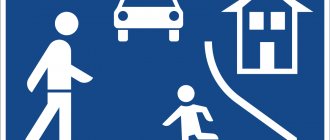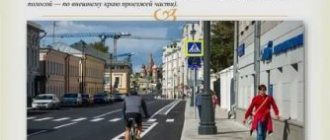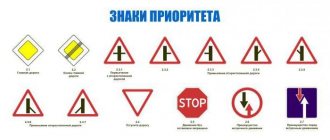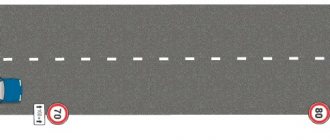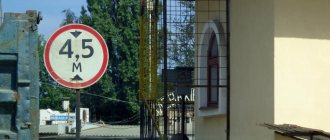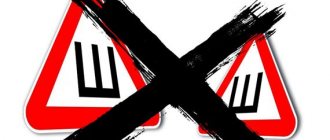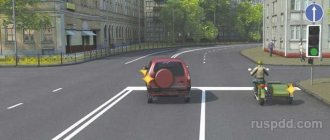Cycling is a popular sport, however, to preserve personal safety, it is necessary to use this type of transport only in designated areas.
Special places where you can travel on such a vehicle have a “cycle path sign”. This designation means that cycling and other types of transport are prohibited on this section of the road.
What does the bike lane sign mean?
Externally, the sign looks like a white bicycle, which is placed on a blue background; the sign itself is round.
This designation means that the area is intended for riding two-wheeled vehicles, while the following features must be observed for other road users:
- vehicles must not cross the zone and use the roadway as a parking space;
- Pedestrians should not travel in the bicycle zone. An exception may be the fact that there is no sidewalk, but the pedestrian must not interfere with the movement of the bicycle.
This type of road is intended for traveling on two-wheelers and scooters.
The main purpose of the bike path is:
- complete safety of travel participants;
- reducing the occurrence of accidents on the roads.
Let's celebrate! Recently, the number of such equipped places for cycling has been growing rapidly. In European countries, the presence of bicycle roads is mandatory, since a large number of residents travel by this type of transport.
What does a bike lane sign look like?
Types of bike paths
There are three types of tracks in Russia:
- a lane for cyclists on a common roadway;
- a special path only for cyclists and moped owners;
- path for cyclists and pedestrians.
The first option is that the edge of the road along which cars drive is marked out for cyclists with a stripe and a curb (not always). Motorists and motorcyclists are not allowed to cross this border, and they must yield to cyclists at intersections.
On one-way streets, an additional lane for two-wheeled non-motorized transport is indicated by a corresponding sign: in a blue square, divided lengthwise into two fields, a bicycle and a short arrow are depicted on one side, and a long arrow on the other. This not only informs cyclists that there is a convenient place to ride, but also prevents car drivers from the temptation to enter an open lane.
On two-way streets, options are possible when bicycle lanes are installed on both sides of the road so that cyclists move towards traffic, or a lane is separated on one side by a curb and a lawn, and this, in turn, is also divided into two lanes.
The place where the bicycle path crosses the main roadway is marked with a square sign with a blue background, divided across: a bicycle and a short arrow are shown on top, and a long arrow below, or vice versa, depending on the direction of travel.
A lane on the roadway is not a very convenient or safe solution, since some drivers tend to either park on it or use it as space for overtaking and other maneuvers. The priority of crossing the street is also often violated.
A path combined with a pedestrian area is much safer. In addition, this is the most common option for bicycle paths in Russia. These areas are marked with a round sign with a bicycle and a human figure drawn on a blue background in white paint. Most often, in such areas there is nothing that would hint at attempts by municipal services to facilitate the movement of cyclists and pedestrians - these are just sidewalks where everyone moves, focusing on the situation and creating inconvenience for others.
In this case, priority remains with pedestrians, and cyclists are forced to maneuver in their flow. The installed sign can only warn the former of the sudden appearance of the latter and inform new cyclists of their right to ride on the sidewalk.
The most preferred, convenient and rare option for a bicycle path is a separate, independent, special zone, which is a mini-copy of the roadway and is divided into two lanes. It is marked with a round blue sign with a picture of a bicycle and is separated from the pedestrian sidewalk by a curb.
There is a rule for such a bike path: you cannot walk on it. This, of course, removes speed limits from the cyclist and allows him to ride calmly, without the fear of bumping someone every minute. Unfortunately, such zones are rare and are located on the embankments of resort cities, in large parks and squares and on the territory of sports and recreational institutions.
Types of sign
Depending on the type of road on which cycling occurs, the signs may have distinctive features.
Tracks can be of various types:
One-way – designed for cyclists to ride in one direction; this type of route has the following features:
- are marked with a special sign;
- has a slight elevation from other movement areas;
- separated from roads by a special buffer zone.
Two-way – cyclists can travel in different directions. Most often they are located in places with a large number of attractions. Also very often this type of road can be found on embankments.
Combined - this type most often adjoins sidewalks and is located at a distance from the highway.
Isolated - designed not only for movement on two-wheeled vehicles, but also for pedestrians.
Good to know! Each type of road must be marked with a corresponding sign at the beginning of the coverage area and at its end, thereby notifying cyclists of the end of the bicycle road.
Sign area
A blue circle with a bicycle logo is installed:
- On the right side of the bicycle section or belt, which is separated from the road surface by side stones or a grass lawn.
- The “Traffic Lane” sign is installed above the bicycle lane, showing the traffic lane covered by the sign or traffic light.
The initial form is established before the start of the bicycle lane, and the repeated form is established after each junction of the secondary road with the bicycle section.
The form with a stencil obliges drivers of cars, other motor vehicles and pedestrians not to enter the special lane. The sign's coverage area ends at the nearest intersection, the intersection of a secondary street. The absence of a repeated established form indicates the end of the separate section for two-wheeled vehicles.
The action of the street sign is also limited by another form - a similar blue circle with a red stripe diagonally. He warns against further movement on a bicycle while in the saddle. The biker should leave the saddle and roll the two-wheeled vehicle by the handlebars.
The presence of a clear bicycle path, but without the installation of a mandatory sign, gives the right to be on it simultaneously to cyclists and drivers of motor vehicles.
Where the sign is installed, its coverage area
This designation can be found in the following places:
- to the right of the marked traffic zone, separated from the sidewalk or roadway by curbs or grass;
- over an area that looks like a marked road on the right side of the roadway. Additionally, it must be established about.
This type of marking can be found in parks and plaza areas. In big cities, bicycle paths are also located in the city center for convenient travel.
The effect of such a designation begins directly in the place where the corresponding mark is placed. If there is an intersection or a turn on the path, after crossing which there is no sign, this means that the zone is over for cycling.
For those roadways where there is no “Bicycle Path” designation, but a bicycle is painted on the asphalt, this means that not only cyclists, but also cars can move along the designated area.
Note! The end of a two-wheeler trail must be marked with a sign showing a bicycle on a blue background, with a red line through it.
What it looks like on the asphalt, coloring book
There is a sign where the bike path begins, and there is also painting on the surface of the road. This is horizontal marking 1.23.3. It is a white image of a bicycle. Sometimes an arrow is drawn just below, showing the direction of movement.
A “Bike Path” sign on the asphalt has the same meaning as one located above the road. He indicates that only non-motorized vehicles and mopeds are allowed to travel from this place. The territory ends with symbol 4.4.2.
No bicycle lane sign
On some sections of the roadway, cycling can be dangerous and therefore prohibited. Then there must be a sign “No bicycle path”. It is numbered 3.9 and has a slightly different name. The symbol is round, is an image of a non-mechanical vehicle on a white background, with a red border along the edge.
The exact name of 3.9 is “No cycling”. It contains a requirement that must be met from the installation site. 3.9 can be found:
- in front of a bridge, tunnel, overpass;
- at the beginning of the high-speed section of the route;
- in front of the industrial zone;
- at the beginning of the protected natural area.
Sometimes a non-mechanical vehicle is not allowed to drive in only one direction. Then next to 3.9 they put signs 8.3.1-8.3.3.
More on AutoLex.Net:
Important road sign "Caution, children!", fine for violation
Its influence ends at the nearest intersection. And if there is a sign next to 3.9, 8.2.1, you need to use it to judge where the symbol’s coverage area will end. After all, this sign indicates the distance at which its requirements should be met.
Watch this video about the concept of “Bike path”:
Sign “Intersection with a bicycle path”: appearance, rules of passage
The sign “Intersection with a bicycle path” (1.24) is directly related to non-motorized vehicles. Other road users should also be attentive to it. After all, the symbol warns that a cyclist may be in the path of the car.
Sign 1.24
1.24 according to GOST it is established:
- in a city or village - 100-150 m before the intersection of the bicycle road and the road;
- outside the populated area - 150-300 m before it;
- at the distance indicated on plate 8.1.1 if it is next to 1.24.
Previously, this symbol determined the priority of a mechanical vehicle. And the cyclist or moped driver was obliged to let the car pass. But now this clause has been excluded from the traffic rules. And the intersection of a bike path with a road is considered an intersection. If it is not regulated, there are no priority symbols, the rules of passage are:
At an intersection of equivalent roads, except in the case provided for in paragraph 13.11(1) of the Rules, the driver of a trackless vehicle is obliged to give way to vehicles approaching from the right.
That is, when a cyclist comes from this side, the car gives way. If they change roles, the driver of a non-motorized vehicle must wait.
All this means that a motorist cannot drive in the 1.24 zone, as in the expressway. At the border of the sign, he should slow down so that if something happens he has time to brake smoothly.
In addition, we should not forget about clause 13.1 of the traffic rules:
When turning right or left, the driver must give way to pedestrians and cyclists crossing the roadway onto which he is turning.
You cannot overtake in the influence zone 1.24; maneuvering in this area is dangerous. It is also prohibited to drive in reverse, as required by paragraph 8.12 of the traffic rules:
Reversing is prohibited at intersections and in places where turning around is prohibited in accordance with paragraph 8.11 of the Rules.
Speed and order of movement
When riding, a cyclist must follow some general rules:
- in order to turn in any direction, you need to raise your arm bent at the elbow in the direction of the turn;
- When braking, you should raise your hand;
- when entering the path from the roadway, you must indicate with an outstretched arm the direction in which the movement will take place;
- it is necessary to cross streets at intersections only after the cyclist has made sure that vehicles allow him to pass;
- if, when crossing a pedestrian path and a highway (the corresponding sign 1.24 should hang), a cyclist needs to cross the road, he must slow down and let vehicles pass, only then continue on his way;
- If there is no special path for driving, you must cross the highway, including at a pedestrian crossing, on foot.
In many countries where such a means of transport is developed, there are special traffic lights in driving areas.
The speed of movement in the city should not exceed 60 km/h, in densely populated areas (in courtyards and parks) the speed should not exceed 20 km.
Let's celebrate! That children under 14 years of age do not have the right to move independently on the road without an appropriate mark.
Traffic rules
Unfortunately, only a small part of cyclists know the traffic rules
Riding a bicycle requires following the rules of the road. This allows you to reduce injuries, avoid emergency situations, and save life and health. Everyone is required to know and comply with these requirements, including young cyclists, who are allowed to ride independently on city streets only within specially designated areas.
Sign area
The end of the bicycle path may be indicated by a special sign 4.4.2 or by the nearest intersection
The presence of sign 4.4.1 instructs all road users to use the corresponding section of the road for its intended purpose: do not walk for pedestrians, do not drive cars. Its coverage area is limited to the nearest intersections, i.e. if there is no sign behind the intersection, this indicates that the separate zone for cyclists has ended.
To limit the effect of this sign, a special sign 4.4.2 can be used, indicating the end of the bicycle path. It looks similar with a red diagonal strikeout stripe. The black silhouette of a bicycle on a white background, edged with a red stripe, strictly prohibits riding on a two-wheeled friend. In the area of effect of this sign, you must dismount and drive the vehicle.
If the bicycle path is a dedicated section of the roadway with markings in the form of a bicycle, but sign 4.4.1 is not installed, then both owners of two-wheelers and ordinary cars can move along this lane.
Speed and order of movement
In Russia, special traffic lights for cyclists are rare
In large cities with heavy traffic, special traffic lights are provided for cyclists, indicated either by a special table - a black silhouette on a white background, or by a separate traffic light window in which the silhouette of a bicycle of a certain color lights up.
Like any driver, a cyclist is obliged to warn in advance about the start of a maneuver:
- a raised corresponding arm bent at the elbow warns of a turn to the side;
- Braking is signaled by any hand raised up.
When driving along a designated section of the roadway, you should pay attention to the signs near the intersection of streets:
- if 4.4.1 hangs, then you can continue driving straight, making sure that cars turning right allow the bicycle to pass;
- if 1.24 is set, then the cyclist is obliged to slow down and let the car pass.
The speed limit is the same for all types of transport: within the city limits no faster than 60 km/h, in courtyards - 20 km/h.
In the absence of a specially designated traffic lane, a cyclist can move:
- along the side of the road - as part of a convoy or when transporting large cargo on the trunk;
- along the pedestrian path - with a child under 7 years old.
Children under 14 years of age are not allowed to ride a bicycle independently outside special sections of the road.
Sign Pedestrian path sign features and exceptions Video
Almost every person knows the Pedestrian Path sign. After all, it is along it that pedestrians move calmly in cities. But what kind of sign indicates a pedestrian path, and what rules exist regarding this sign, will be discussed in this article.
Features of the pedestrian zone sign
Let's start with what the sign looks like, indicating a pedestrian path. Recognizing it will not be difficult even for a child. It is round in shape and depicts a moving man on a blue background. The outline of the sign is white.
The road sign “Pedestrian path” allows only pedestrians to move along the road section. All vehicles are strictly prohibited from parking or stopping in this place.
It is worth noting that the traffic rules for cyclists also allow them to enter this area.
Many people confuse a pedestrian path with a crossing. The latter is designed for people to cross the roadway and is an integral part of the road.
It is indicated both by a corresponding sign and by markings on the road - the well-known “zebra”.
Many may ask, what are the differences between a path and a sidewalk? The answer is simple: the sidewalk is part of the road, and the pedestrian zone is an independent element. And driving a vehicle onto this element will cost the driver a fine of 2,000 rubles.
Exceptions to the rules - with whom do pedestrians share space?
As already mentioned, in addition to pedestrians, cyclists can move in this area. But in fact, there are still some exceptions to the rules. This applies to road and utility vehicles that need to correct any operational issue in this area.
In addition to them, vehicles of commercial enterprises fall into this category of exceptions to the rules when they are located in the track area. For example, if a car needs to transport some cargo or goods to an enterprise. In this case, entry into the pedestrian traffic area may be permitted (the basis is section 9.9 of the traffic rules).
But having these privileges, the driver of the vehicle must remember and follow the following rules:
- Entry to the territory of the pedestrian path can only be carried out when there is no other access to the destination of the vehicle.
- It is necessary to monitor traffic safety on the pedestrian path - pedestrians remain the main priority in this area.
- Traffic on the path section should be kept to a minimum.
Pedestrians, in turn, in the event of an exception to the rules, must behave as carefully as possible - monitor the movement of the car and give way to it if there is a danger of an accident for the car.
We are improving the “Pedestrian path” sign – more and more visible, more and more bright!
The question of how to better protect pedestrians and prevent vehicles from entering the pedestrian path is always relevant. But currently some improvements to this sign are already underway. One of them is to equip it with LEDs to make it more visible.
Light warning systems are partially installed at pedestrian crossings, for example, in Moscow and Yekaterinburg. With its help, this sign stands out from others with a blinking yellow signal. This system works by collecting sunlight. During the day, she absorbs it, recharging herself at the same time. And in the dark it works, illuminating the road sign.
